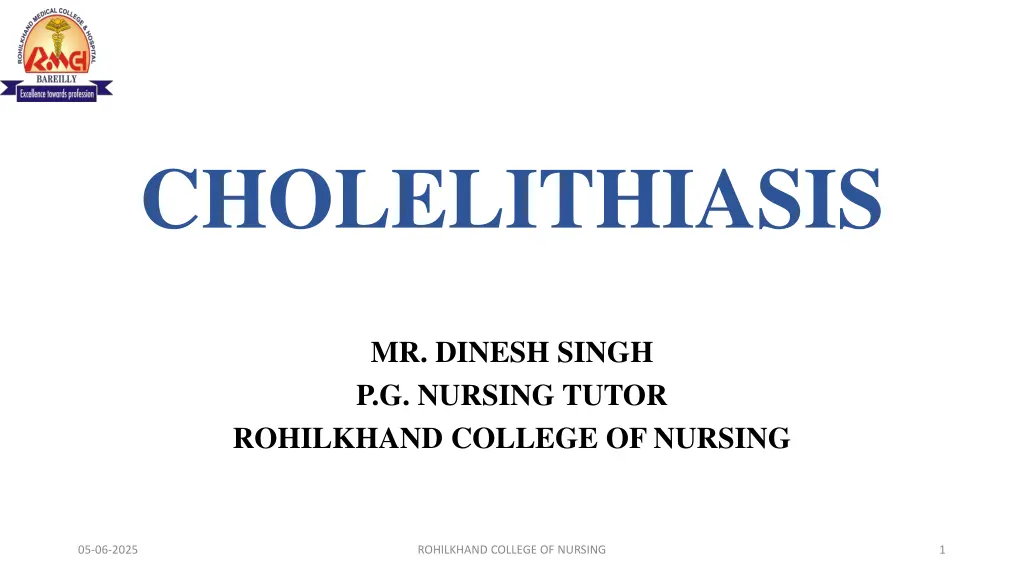
Understanding Cholelithiasis: Causes, Symptoms, and Management
Learn about cholelithiasis, a condition characterized by the formation of gallstones in the gallbladder. Explore the causes, clinical manifestations, diagnostic evaluation, management strategies, and prevention methods of cholelithiasis. Gain insights into the pathophysiology and etiology of this condition. Find out more at Rohilkhand College of Nursing.
Download Presentation

Please find below an Image/Link to download the presentation.
The content on the website is provided AS IS for your information and personal use only. It may not be sold, licensed, or shared on other websites without obtaining consent from the author. If you encounter any issues during the download, it is possible that the publisher has removed the file from their server.
You are allowed to download the files provided on this website for personal or commercial use, subject to the condition that they are used lawfully. All files are the property of their respective owners.
The content on the website is provided AS IS for your information and personal use only. It may not be sold, licensed, or shared on other websites without obtaining consent from the author.
E N D
Presentation Transcript
CHOLELITHIASIS MR. DINESH SINGH P.G. NURSING TUTOR ROHILKHAND COLLEGE OF NURSING 05-06-2025 ROHILKHAND COLLEGE OF NURSING 1
OBJECTIVES Introduction of the Cholelithiasis. Define the Cholelithiasis Explain the causes of Cholelithiasis. State the clinical manifestations of Cholelithiasis. Elaborate the diagnostic evaluation of Cholelithiasis. Discuss the management of Cholelithiasis. Describe the prevention of Cholelithiasis. 05-06-2025 ROHILKHAND COLLEGE OF NURSING 2
INTRODUCTION Gallstones are hardened deposits of digestive fluid that can form in the gallbladder. The gallbladder is a small, pear-shaped organ on the right side of the abdomen, just beneath the liver. The gallbladder holds a digestive fluid called bile that's released into the small intestine. 05-06-2025 ROHILKHAND COLLEGE OF NURSING 3
DEFINITION Cholelithiasis is a formation of calculi or gall stones in the gallbladder from the solid composition is known as cholelithiasis. There are two types of gall stones: 1. Those composed of pigment 2. Those composed of cholesterol 05-06-2025 ROHILKHAND COLLEGE OF NURSING 4
05-06-2025 ROHILKHAND COLLEGE OF NURSING 5
ETIOLOGY Bile contains too much cholesterol: Normally, bile contains enough chemicals to dissolve the cholesterol excreted by the liver. But if liver excretes more cholesterol than bile can dissolve, the excess cholesterol may form into crystals and eventually into stones. Bile contains too much bilirubin: Bilirubin is a chemical that's produced when body breaks down red blood cells. Certain conditions cause liver to make too much bilirubin, including liver cirrhosis, biliary tract infections and certain blood disorders. The excess bilirubin contributes to gallstone formation. 05-06-2025 ROHILKHAND COLLEGE OF NURSING 6
PATHOPHYSIOLOGY Decreased bile acid synthesis Increased cholesterol synthesis in the liver Super saturation of bile with cholesterol Formation of precipitates Gall stones (cholelithiasis) Inflammatory changes (cholecystitis) 05-06-2025 ROHILKHAND COLLEGE OF NURSING 7
CLINICAL MANIFESTATION Feeling of fullness Abdominal distention Pain in the right upper quadrant of abdomen Indigestion Changes in urine and stool color Fever Nausea, vomiting Vitamin K deficiency 05-06-2025 ROHILKHAND COLLEGE OF NURSING 8
DIAGNOSTIC EVALUATION History Collection Physical Examination Abdominal X-ray Ultra sonography Cholecystography Percutaneous Transhepatic Cholangiography (PTCA) 05-06-2025 ROHILKHAND COLLEGE OF NURSING 9
MANAGEMENT Analgesics (For reducing pain) Eg. Acetaminophen, Aspirin Antacids: (To reduce the amount of acid in stomach) Eg. Calcium carbonate, magnesium carbonate. Antiemetics: (to reduce the vomiting) Eg. Emset 05-06-2025 ROHILKHAND COLLEGE OF NURSING 10
SURGICAL MANAGEMENT Cholecystectomy (surgical removal of gallbladder) Cholelithotomy (Removal of gall stones) 05-06-2025 ROHILKHAND COLLEGE OF NURSING 11
NURSING MANAGEMENT Assess the level of pain, consciousness level, activity level. Enquire about the anxiety/stress, perception about disease. Assess about respiratory status, nutritional status. Monitor vital sign 05-06-2025 ROHILKHAND COLLEGE OF NURSING 12
HEALTH EDUCATION Give bed rest to the patient. Analgesics and Antibiotics are given to the patient The diet is restricted to low fat, liquids, high protein and carbohydrates. Avoid eggs, cream, fried food, cheese and gas forming vegetables and alcohol. 05-06-2025 ROHILKHAND COLLEGE OF NURSING 13
REFERENCES Brunner and Suddarth s textbook of medical-surgical nursing 10th edition, published by Suzanne C. Smeltzer Brenda Bare . PR Ashalatha, G. Deepa textbook of Anatomy and physiology Fourth edition published by Jaypee Brothers. Linda S. Williams, Paula D. Hopper textbook of Medical Surgical Nursing Third edition Published by F.A. Davis 2007. Priscilla LeMone, Karen Burke, Gerene Bauldoff textbook of Medical Surgical Nursing Fifth edition published by Julie Levin Alexander . Lewis Dirksen Heitkemper Bucher, textbook of medical surgical nursing second south Asia edition, volume 1. 05-06-2025 ROHILKHAND COLLEGE OF NURSING 14
05-06-2025 ROHILKHAND COLLEGE OF NURSING 15



